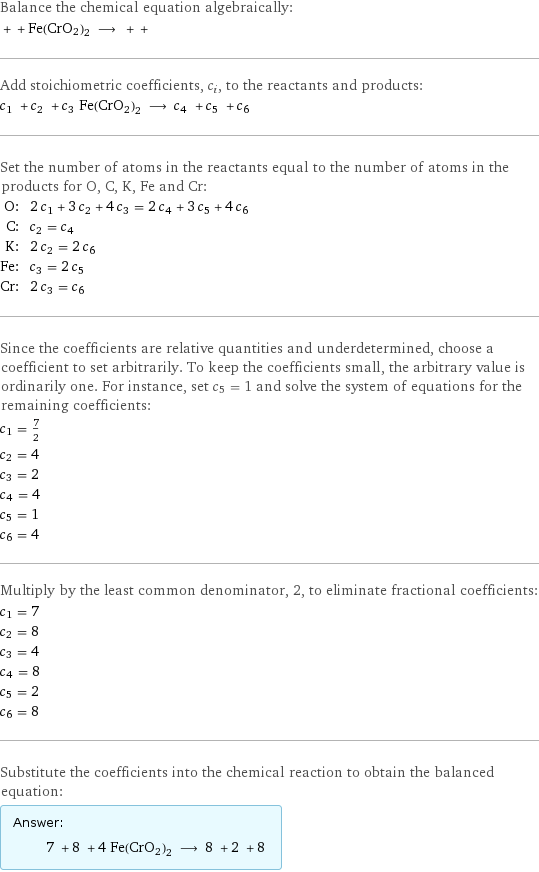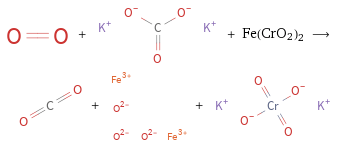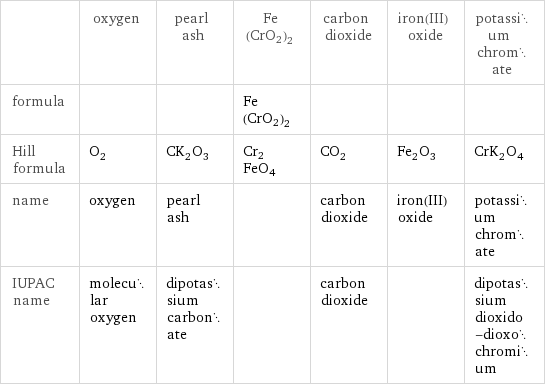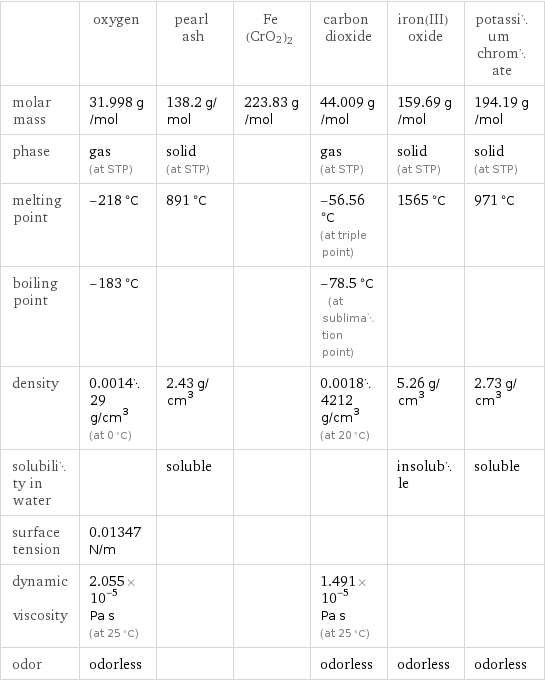Input interpretation

oxygen + pearl ash + Fe(CrO2)2 ⟶ carbon dioxide + iron(III) oxide + potassium chromate
Balanced equation

Balance the chemical equation algebraically: + + Fe(CrO2)2 ⟶ + + Add stoichiometric coefficients, c_i, to the reactants and products: c_1 + c_2 + c_3 Fe(CrO2)2 ⟶ c_4 + c_5 + c_6 Set the number of atoms in the reactants equal to the number of atoms in the products for O, C, K, Fe and Cr: O: | 2 c_1 + 3 c_2 + 4 c_3 = 2 c_4 + 3 c_5 + 4 c_6 C: | c_2 = c_4 K: | 2 c_2 = 2 c_6 Fe: | c_3 = 2 c_5 Cr: | 2 c_3 = c_6 Since the coefficients are relative quantities and underdetermined, choose a coefficient to set arbitrarily. To keep the coefficients small, the arbitrary value is ordinarily one. For instance, set c_5 = 1 and solve the system of equations for the remaining coefficients: c_1 = 7/2 c_2 = 4 c_3 = 2 c_4 = 4 c_5 = 1 c_6 = 4 Multiply by the least common denominator, 2, to eliminate fractional coefficients: c_1 = 7 c_2 = 8 c_3 = 4 c_4 = 8 c_5 = 2 c_6 = 8 Substitute the coefficients into the chemical reaction to obtain the balanced equation: Answer: | | 7 + 8 + 4 Fe(CrO2)2 ⟶ 8 + 2 + 8
Structures

+ + Fe(CrO2)2 ⟶ + +
Names

oxygen + pearl ash + Fe(CrO2)2 ⟶ carbon dioxide + iron(III) oxide + potassium chromate
Chemical names and formulas

| oxygen | pearl ash | Fe(CrO2)2 | carbon dioxide | iron(III) oxide | potassium chromate formula | | | Fe(CrO2)2 | | | Hill formula | O_2 | CK_2O_3 | Cr2FeO4 | CO_2 | Fe_2O_3 | CrK_2O_4 name | oxygen | pearl ash | | carbon dioxide | iron(III) oxide | potassium chromate IUPAC name | molecular oxygen | dipotassium carbonate | | carbon dioxide | | dipotassium dioxido-dioxochromium
Substance properties

| oxygen | pearl ash | Fe(CrO2)2 | carbon dioxide | iron(III) oxide | potassium chromate molar mass | 31.998 g/mol | 138.2 g/mol | 223.83 g/mol | 44.009 g/mol | 159.69 g/mol | 194.19 g/mol phase | gas (at STP) | solid (at STP) | | gas (at STP) | solid (at STP) | solid (at STP) melting point | -218 °C | 891 °C | | -56.56 °C (at triple point) | 1565 °C | 971 °C boiling point | -183 °C | | | -78.5 °C (at sublimation point) | | density | 0.001429 g/cm^3 (at 0 °C) | 2.43 g/cm^3 | | 0.00184212 g/cm^3 (at 20 °C) | 5.26 g/cm^3 | 2.73 g/cm^3 solubility in water | | soluble | | | insoluble | soluble surface tension | 0.01347 N/m | | | | | dynamic viscosity | 2.055×10^-5 Pa s (at 25 °C) | | | 1.491×10^-5 Pa s (at 25 °C) | | odor | odorless | | | odorless | odorless | odorless
Units
